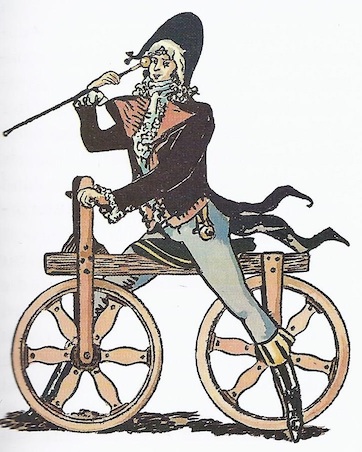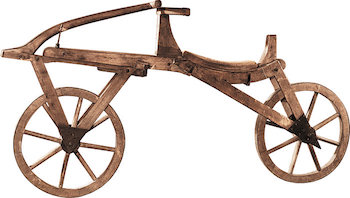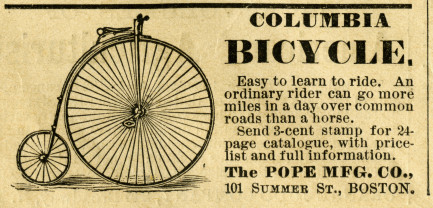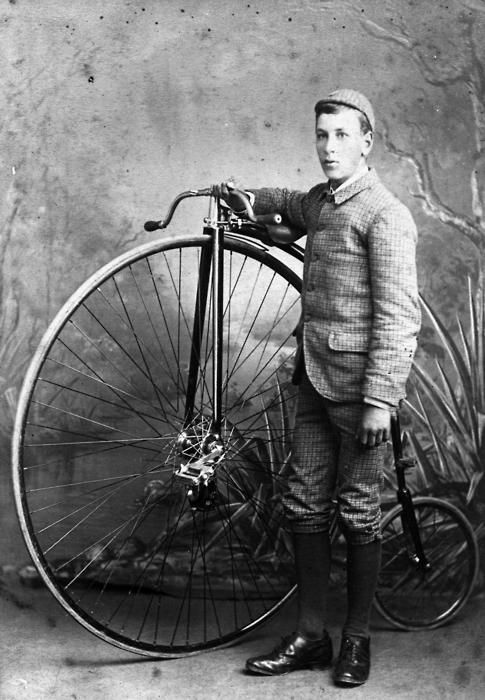“Let me tell you what I think of bicycling. I think it has done more to emancipate women than anything else in the world. It gives women a feeling of freedom and self-reliance. I stand and rejoice every time I see a woman ride by on a wheel…the picture of free, untrammeled womanhood.” ― Susan B. Anthony
Here is a bit of history you might not know about. It is surprisingly important to many of us. It may be the reason why you are alive today. It may have have been the reason your great-grandparents met and eventually married.
We all know about popular fads: the hula hoops of the fifties, the pet rocks of the sixties, and body-piercing jewelry of the present time. The young people generally embrace fads with open arms while older generations wring their hands and wonder what the younger generation is coming to. However, we generally do not think about fads in the times of our ancestors. A quick bit of historical study shows that our ancestors were just as enthusiastic about new ideas and fashions as are any of their descendants. Some of these fads had far-reaching effects on future generations. In fact, some of us might not be here today had it not been for one of these fads.
One item that we take for granted today is the bicycle. Yet this two-wheeled device was all the rage when first introduced in the late 1870s. To be sure, two-wheel conveyances had been invented much earlier but were rarely seen.
 In 1790, Frenchman Chevalier de Sivrac conceived the idea of a crude form of a bicycle, consisting of a wooden beam with wheels attached below each end. It had no pedals; the rider pushed along the ground with his feet. It had no steering capability. Even worse, it had no seat. The rider simply sat on the beam. Apparently de Sivrac built only one of these, and it was soon relegated to a storage shed. Later models improved on the earlier design with a cushioned seat of some sort. In 1813, Baron Charles de Drais of Saurbrun, Germany, introduced a bicycle that was similar to Sivrac's model but with a swivel head to aid steering.
In 1790, Frenchman Chevalier de Sivrac conceived the idea of a crude form of a bicycle, consisting of a wooden beam with wheels attached below each end. It had no pedals; the rider pushed along the ground with his feet. It had no steering capability. Even worse, it had no seat. The rider simply sat on the beam. Apparently de Sivrac built only one of these, and it was soon relegated to a storage shed. Later models improved on the earlier design with a cushioned seat of some sort. In 1813, Baron Charles de Drais of Saurbrun, Germany, introduced a bicycle that was similar to Sivrac's model but with a swivel head to aid steering.
 At the end of 1818 or early in 1819, Baron Drais introduced an improved model, called "The Draisene". These "Draisenes" were very expensive, and only the very rich could buy them. During these years riding was in full swing in New York, where the machines were called "Dandy Horses." There was even a riding rink on "Bowling Green," where adventurous souls could rent machines and take riding lessons. The sidewalks of City Hall Park and the Bowery provided favorite courses for the riders. The "Dandy Horse" fad also spread to Boston, Philadelphia, and other cities on the North American continent. Even so, these machines existed in miniscule numbers. They were known by a variety of names, but the word "bicycle" had not yet been invented.
At the end of 1818 or early in 1819, Baron Drais introduced an improved model, called "The Draisene". These "Draisenes" were very expensive, and only the very rich could buy them. During these years riding was in full swing in New York, where the machines were called "Dandy Horses." There was even a riding rink on "Bowling Green," where adventurous souls could rent machines and take riding lessons. The sidewalks of City Hall Park and the Bowery provided favorite courses for the riders. The "Dandy Horse" fad also spread to Boston, Philadelphia, and other cities on the North American continent. Even so, these machines existed in miniscule numbers. They were known by a variety of names, but the word "bicycle" had not yet been invented.
Development of two-wheeled conveyances continued, mostly in England, Scotland, Germany, and France. In 1862, Pierre Lallement first coined the word "bicycle" to describe his new invention. It was the first to have cranks and pedals attached to the front wheel, the forerunner of today's design. The front wheel was much larger that the rear one, and the device had thick iron tires and a saddle resting on a heavy iron backbone. It shook terribly on the rough roads and cobbled streets of Paris, causing people to call it "the boneshaker." Lallement's employer, a Frenchman named M. Michaux, bought Lallement's patent and opened a bicycle shop.
In 1865 or 1866 Lallement moved to the United Sates, taking with him a number of partly finished pieces of a much-improved bicycle over his "boneshaker" model of 1862. He settled in Ansonia, Connecticut. In 1866 he rode his latest bicycle on the green, or public square, of nearby New Haven. On May 4, 1866, his specifications and drawings were filed in the U.S. Patent Office. This was the first bicycle patent ever issued in the United States. Lallement was unable to find financial backing, however, and he soon returned to France.
Calvin Witty, a New York manufacturer, purchased the patent from Lallement for $10,000 and set up production. Later American makers were forced to pay Witty a royalty of $20.00 per machine, a significant amount of money at the time. In 1870 Lallement returned to America to seek his fortune. He worked as a mechanic for a while but eventually disappeared from sight.
 While bicycles were being manufactured in America, their numbers were small until 1877, when Augustus Pope opened a factory in Hartford, Connecticut, and started manufacturing the Columbia bicycle, a brand name that still exists today. Pope's creation was called the penny-farthing because of its large front wheel and tiny back wheel (similar to the very large and small English coins).
While bicycles were being manufactured in America, their numbers were small until 1877, when Augustus Pope opened a factory in Hartford, Connecticut, and started manufacturing the Columbia bicycle, a brand name that still exists today. Pope's creation was called the penny-farthing because of its large front wheel and tiny back wheel (similar to the very large and small English coins).
Within months bicycling became a fad in America, spreading like wildfire. Pope and his newly-formed competitors built tens of thousands of bicycles, perhaps even hundreds of thousands. Within a year the new devices were appearing in cities and rural areas alike. The bicycle immediately became a common summertime sight everywhere in America as well as throughout much of Europe and the United Kingdom.
The younger generation found a mobility that had previously been unknown: men and women alike could jump on a bicycle and easily travel five or ten miles within an hour or two. Such a trip previously required the better part of a day with a horse and carriage. Dating patterns changed. Young men were able to go further and further from home in search of romance. Marriage patterns changed and, yes, it is probable that some of us alive today are here because of the invention of the bicycle.

Can you picture your great-grandfather in his Sunday best with bowler hat, riding across the countryside on a high-wheeled penny-farthing bicycle to visit the young lady who was to become your great-grandmother? I wonder what her parents, your great-great-grandparents, thought of the young man riding that foolish contraption.
P.S.
The world has changed. Here is a picture of my (new) bicycle:

It has a 1,000-watt electric motor and you can see the huge battery just above and to the left of the pedals.